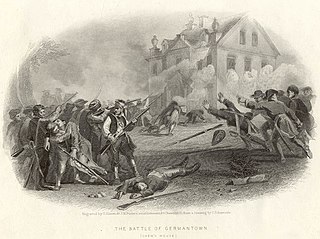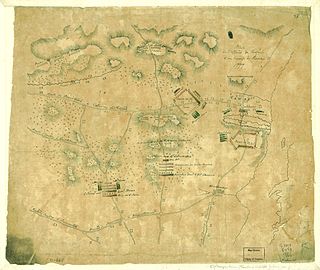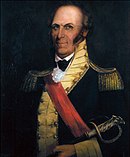
The Battle of Germantown was a major engagement in the Philadelphia campaign of the American Revolutionary War. It was fought on October 4, 1777, at Germantown, Pennsylvania, between the British Army led by Sir William Howe, and the American Continental Army under George Washington.
This is the complete order of battle of Allied and German forces involved during Operation Market Garden.
This is the complete order of battle of opposing forces at the Battle of Balaclava.
The 6th Pennsylvania Regiment, first known as the 5th Pennsylvania Battalion, was a unit of the United States of America (U.S.) Army, raised December 9, 1775, at Philadelphia, Pennsylvania, for service with the Continental Army. The regiment would see action during the New York Campaign, Battle of Brandywine, Battle of Germantown, Battle of Monmouth, and Green Spring. The regiment was disbanded on January 1, 1783.
The 8th Pennsylvania Regiment or Mackay's Battalion was an American infantry unit that became part of the Continental Army during the American Revolutionary War. Authorized for frontier defense in July 1776, the eight-company unit was originally called Mackay's Battalion after its commander, Colonel Aeneas Mackay. Transferred to the main army in November 1776, the unit was renamed the 8th Pennsylvania Regiment on 1 January 1777. It completed an epic winter march from western Pennsylvania to New Jersey, though Mackay and his second-in-command both died soon afterward. In March 1777 Colonel Daniel Brodhead assumed command. The regiment was engaged at the Battles of Bound Brook, Brandywine, Paoli, and Germantown in 1777. A body of riflemen were detached from the regiment and fought at Saratoga. Assigned to the Western Department in May 1778, the 8th Pennsylvania gained a ninth company before seeing action near Fort Laurens and in the Sullivan Expedition in 1778 and 1779. The regiment consolidated with the 2nd Pennsylvania Regiment in January 1781 and ceased to exist.
The 11th Pennsylvania Regiment or Old Eleventh was authorized on 16 September 1776 for service with the Continental Army. On 25 October, Richard Humpton was named colonel. In December 1776, the regiment was assigned to George Washington's main army and was present at Assunpink Creek and fought at Princeton in January 1777. During the spring, the unit assembled at Philadelphia, Pennsylvania in a strength of eight companies. The soldiers were recruited from Philadelphia and four nearby counties. On 22 May 1777, the regiment became part of the 2nd Pennsylvania Brigade. The 11th was in the thick of the action at Brandywine, Paoli, and Germantown in 1777. It was present at White Marsh and Monmouth. On 1 July 1778, the unit was consolidated with the 10th Pennsylvania Regiment, and the 11th Regiment ceased to exist. Humpton took command of the reorganized unit.
The 8th Virginia Regiment or German Regiment was an infantry unit that served in the Continental Army during the American Revolutionary War. Authorized in January 1776, the regiment was raised from men of several northwestern counties in the strength of 10 companies. Its first commander was Colonel Peter Muhlenberg, a clergyman and militia leader. The unit marched to defend Charleston, South Carolina in 1776, but saw no fighting. At the start of 1777, the 8th Virginia moved to join George Washington's main army. When Muhlenberg was promoted to general officer, Colonel Abraham Bowman took command of the unit.
The 2nd North Carolina Regiment was an American infantry unit that was raised for the Continental Army during the American Revolutionary War. In 1776 the regiment helped defend Charleston, South Carolina. Ordered to join George Washington's main army in February 1777, the regiment subsequently fought at Brandywine and Germantown during the Philadelphia Campaign. After most other North Carolina regiments were sent home to recruit, the 1st and 2nd Regiments remained with the main army and fought at Monmouth in June 1778. The regiment was transferred to the Southern Department and was captured by the British army in May 1780 at the Siege of Charleston. Together with the 1st Regiment, the unit was rebuilt and fought capably at Eutaw Springs. The 2nd was furloughed in April 1783 and officially dissolved in November 1783.

The siege of Yorktown was the culminating act of the Yorktown campaign, a series of military operations occupying much of 1781 during the American Revolutionary War. The siege was a decisive Franco-American victory: after the surrender of British Lt. Gen. Charles, Earl Cornwallis on October 17, the government of Lord North fell, and its replacement entered into peace negotiations that resulted in British recognition of American independence with the 1783 Treaty of Paris.

The Battle of the Short Hills was a conflict between a Continental Army force commanded by Brigadier General William Alexander, and an opposing British force commanded by Lieutenant General William Howe. The battle took place on June 26, 1777, at Scotch Plains and Edison, New Jersey, during the American Revolutionary War.

The Battle of Germantown on 4 October 1777 pitted a 9,000-man British army under General William Howe, 5th Viscount Howe against an 11,000-strong American army commanded by General George Washington. After an initial advance, the American reserve allowed itself to be diverted by 120 English soldiers holding out in the Benjamin Chew House. A heavy morning fog disoriented the American assault columns and led to a friendly fire incident between elements of Major General John Sullivan's right column and Major General Nathanael Greene's left column. At about this time, the American attack lost impetus and both columns retreated. Meanwhile, two wide flanking columns numbering 3,000 American militia had little effect on the outcome. American losses was numbered at 673 soldiers killed and wounded plus 400 captured, while the British suffered 520 casualties.

Sir George Osborn, 4th Baronet was a British Army officer and politician. He fought in the American Revolutionary War as a British officer. He served in the House of Commons from 1769 to 1784 - before, during, and after that conflict. In 1777 he led a detachment of the Guards Brigade at the battles of Brandywine and Germantown. Besides his combat duties, he served as the inspector of the Hessian mercenary soldiers. After returning from America in 1777 he was promoted in rank to general officer. In 1787 he received advancement to lieutenant general. He is remembered in United States history for a clever but harsh comment that he made concerning the dead body of an American officer.
Edward Mathew began his military career in the British Army as a commissioned officer. By the time of the American Revolutionary War he had risen to the rank of colonel. Promoted to brigadier general, he was assigned to command the elite Brigade of Guards in the American campaign. In 1776 he led the Guards at Long Island, Kip's Bay, and Fort Washington where he spearheaded one of the assault forces. In the Philadelphia Campaign, he commanded his brigade at Brandywine, Germantown, White Marsh, and Monmouth. As a major general, he took part in the highly successful Chesapeake raid on Virginia ports in 1779. He led one of the columns in action at Battle of Springfield in 1780. He commanded in the West Indies in 1782 and became a full general in 1797. His beloved daughter Anna predeceased him in 1795. Mathew is likely to have been the model for a character in one of Jane Austen's novels.
Philippe Hubert, Chevalier de Preudhomme de Borre joined the French Army in 1740 and served in the War of the Austrian Succession. During the American Revolutionary War he traveled to America where he was presented as a military expert. Promoted to general officer, his career as a Continental Army officer was brief and undistinguished. He resigned under a cloud and returned to France in 1779. His career ended in obscurity.
The 4th Continental Artillery Regiment, also known as Reign's Continental Artillery Regiment, was an American military unit during the American Revolutionary War. The regiment became part of the Continental Army on 10 June 1777 as Colonel Thomas Proctor's Continental Artillery Regiment. It was made up of eight artillery companies from eastern Pennsylvania. At the time of the regiment's formation, two companies were already in existence, one from as early as October 1775. One company served at Trenton in December 1776 where it performed well in action. In February 1777, Pennsylvania expanded its two-company battalion into an eight-company regiment. After officially joining the Continental Army, the regiment saw much fighting in the Philadelphia campaign in late 1777. Elements of Proctor's Regiment fought at Monmouth in June 1778 and joined the Sullivan Expedition in summer 1779.
Henry Monckton was the fourth son of John Monckton, 1st Viscount Galway, and the younger half-brother of the more famous Robert Monckton.

Walter Stewart was an Irish-born American general in the Continental Army during the American Revolutionary War.
Hartley's Additional Continental Regiment was an American infantry unit of the Continental Army that served for two years during the American Revolutionary War. The regiment was authorized in January 1777 and Thomas Hartley was appointed its commander. The unit comprised eight companies from Pennsylvania, Maryland, and Delaware. When permanent brigades were formed in May 1777, the regiment was transferred to the 1st Pennsylvania Brigade. Hartley's Regiment fought at Brandywine, Paoli, and Germantown in 1777. The unit helped defend the Pennsylvania frontier against indigenous raids in the Summer and early Fall of 1778. In January 1779, following a resolution of the Continental Congress the regiment, along with Patton's Additional Continental Regiment and part of Malcolm's Additional Continental Regiment, were combined to form a complete battalion known as the "New" 11th Pennsylvania Regiment. The 11th participated in the Sullivan Expedition in the summer of that year. In January 1781 the 11th merged with the 3rd Pennsylvania Regiment and ceased to exist.
The "German Battalion" was an infantry formation of the Continental Army during the American Revolutionary War. Authorized in May 1776 as an extra Continental regiment, the battalion recruited ethnic Germans from Maryland and Pennsylvania.

Oliver Spencer was a New Jersey officer during the American Revolutionary War and received a special commission to enlist and lead one of 16 Additional Continental Regiments. He was born in Connecticut and later moved to New Jersey, where he married Anna Ogden and became a tanner. He joined the revolutionary cause and engaged a British force in December 1776 as a major of New Jersey militia. On 15 January 1777 during the Forage War, his militiamen captured 70 German mercenaries. That month George Washington authorized him to recruit Spencer's Additional Continental Regiment. As colonel, he led this unit at Brandywine and Germantown in 1777 and Monmouth in 1778. His regiment participated in the Sullivan Expedition in 1779 and was disbanded at the beginning of 1781. The conflict having ruined his home and his tanning business, he moved to Ohio, where he served as a probate judge and militia commander. He was the nephew of General Joseph Spencer.

















